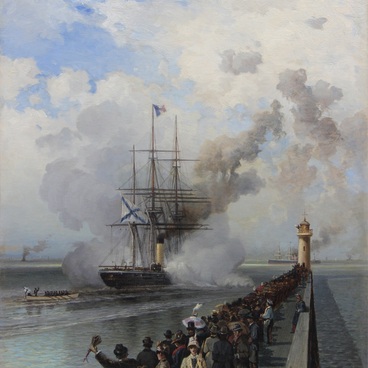The wooden sculpture Christ in Prison, presented at the exhibition, was created by an unknown master in 18th century. The sculpture is colored with oil paints and varnished, thanks to which the paints have survived to this day. An unknown artist showed Christ’s figure quite schematically, because he probably did not have sufficient technical skills to create a more detailed and realistic image.
As to the style of carving, figurative composition and stylistic features, Christ in Prison has much in common with sculptural monuments of 18th century from the collections of State Russian Museum and Perm State Art Gallery.
Such wooden sculptures appeared in Russian churches only in 17th and 18th centuries. They were especially popular in the agricultural areas of the Volga region and the Russian North, as well as among Russian population in small hunting or mining towns of Siberia.
The sculpture Christ in Prison was created in the tradition of three-dimensional carving, which had not been represented in Russian art for several centuries. Art critics also note some features of European classicism and baroque art in this work.
However, statues on this subject were most common in Russia, while West European sculptors almost never addressed it. In Russian churches and chapels, such monuments were usually covered with brocade and velvet robes.
Official representatives of Russian Orthodox Church in 17th and 18th centuries more than once imposed a ban on installing such statues in churches, as well as on creating such sculptures. They were considered as results of Catholic influence or Latinism, and were called idols, dummies or graven images. There was a legend according to which wooden religious statues were brought to Russia by False Dmitry I. It was allegedly he who started donating such sculptures to monasteries and churches on his way from Poland to Moscow. This legend correlated with the negative opinion of Russian historians of past centuries towards False Dmitry’s personality and activities: he was severely criticized for usurping power and violating the sacred procedure of tsar’s accession to throne.
As to the style of carving, figurative composition and stylistic features, Christ in Prison has much in common with sculptural monuments of 18th century from the collections of State Russian Museum and Perm State Art Gallery.
Such wooden sculptures appeared in Russian churches only in 17th and 18th centuries. They were especially popular in the agricultural areas of the Volga region and the Russian North, as well as among Russian population in small hunting or mining towns of Siberia.
The sculpture Christ in Prison was created in the tradition of three-dimensional carving, which had not been represented in Russian art for several centuries. Art critics also note some features of European classicism and baroque art in this work.
However, statues on this subject were most common in Russia, while West European sculptors almost never addressed it. In Russian churches and chapels, such monuments were usually covered with brocade and velvet robes.
Official representatives of Russian Orthodox Church in 17th and 18th centuries more than once imposed a ban on installing such statues in churches, as well as on creating such sculptures. They were considered as results of Catholic influence or Latinism, and were called idols, dummies or graven images. There was a legend according to which wooden religious statues were brought to Russia by False Dmitry I. It was allegedly he who started donating such sculptures to monasteries and churches on his way from Poland to Moscow. This legend correlated with the negative opinion of Russian historians of past centuries towards False Dmitry’s personality and activities: he was severely criticized for usurping power and violating the sacred procedure of tsar’s accession to throne.

